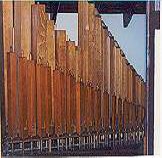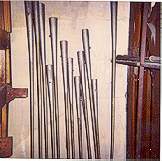Pipe Organ 101 (sort of) | Our Philosophy of Organ Tuning | The Physics of the Organ | How an Organ is tuned | Harmoniums and Reed Organs | Carillons | Harpsichords
(For a fuller explanation of the way in which an organ produces sound, see The Physics of the Organ)
The length of the vibrating air column inside the pipe determines the pitch of any organ pipe, so we can change the pitch of the pipe by changing the length of the air column.
On stopped pipes - which are often made of wood, the air column runs from the top of the mouth of the pipe to the stopper. The stoppers on wooden pipes are often referred to (affectionately - if one can hold affectionate feelings towards a stopper!) as "potato mashers
So stopped pipes may be tuned by adjusting the position of the stopper in relation to the rest of the pipe.
Open pipes are tuned either by moving a "slider" - a section of the pipe that is wider in diameter than the rest and may be slid to extend or shorten the pipe; or by means of a "tuning flap" - a cut out of metal which can be rolled back, much in the manner of a sardine can; or by means of bending the edges of the top of the pipe in or out with an implement called a tuning cone.
Reed pipes
In all cases increasing the length of the vibrating air column will cause the pipe to drop in pitch (sound lower). Shortening the air column will raise the pitch (the pipe will sound higher).
All things being equal (though in the world of organs, as in life, they seldom are!) An increase in temperature will cause the overall pitch of the organ to increase, and a lowering of temperature will engender a corresponding lowering of pitch.
Unlike the piano, which goes out of tune primarily (but not exclusively) from the action of the hammers hitting the strings in the course of playing, the organ will not go out of tune from any amount of playing (the pipes do not move and are therefore not really subject to wear - although this is a debatable issue where certain kinds of reeds are concerned, but we don't need to split hairs, or even tuning wires!). The organ goes out of tune from changes in temperature and other atmospheric conditions, as well as from subjugation to external vibrations.
Case in point, an organ tuned at A=440 Hertz at 70 degrees (so called "concert pitch" in America) will go flat as the temperature drops, or sharp if there is an increase in temperature. Within a few degrees the organ will remain approximately in tune with itself, even though the "reference point" has changed. But much past a few degrees, because of the way temperature affects different materials differently; the organ will begin to sound out of tune. This is why we prefer to tune organs with the change of seasons.
The reason temperature effects tuning is because objects expand when they are heated and contract when they are cooled. (Again, see the Physics page) Temperature variance changes the size of the pipe (albeit imperceptibly) and this changes the size of the vibrating air column.
Now imagine a piece of metal - one can only bend it so far and still be able to bend it back to its original shape. Anyone who has ever tried to pull the dents out of an automobile fender understands this only too well! After a while changes in temperature begin to degrade the organ's tuning, and it sounds out of tune, even if brought back to exactly the temperature at which it was first tuned. That is why organs go out of tune.
Modern pipe organs (and that term is here used VERY broadly - modern here meaning after the end of the eighteenth century!) are typically tuned, like pianos, in so-called "even temperament" - meaning that the intervals are slightly "false" so that the organ may be played in any key. Older instruments, and organs that are built to replicate instruments from long may be tuned in a variety of "antique" tuning systems which generally allow the instrument to be played in only a few keys.
|
About Us | The Mandeville Organ | The Morey Organ | The Never Ending Project | The Essex Chapel Project | Anything Can Be Fixed | Products And Services | Links | Contact Us | Guest Book

